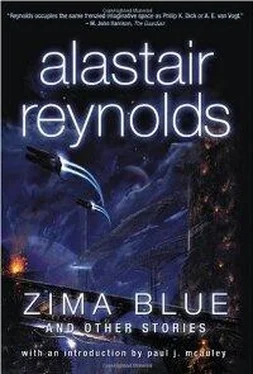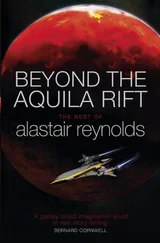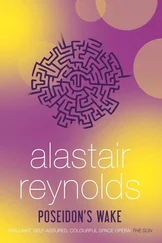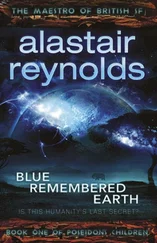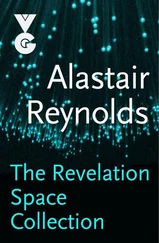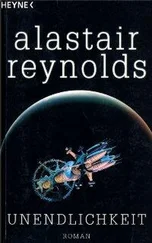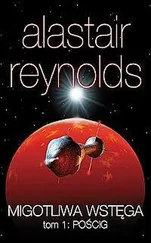Alastair Reynolds - Zima Blue
Здесь есть возможность читать онлайн «Alastair Reynolds - Zima Blue» весь текст электронной книги совершенно бесплатно (целиком полную версию без сокращений). В некоторых случаях можно слушать аудио, скачать через торрент в формате fb2 и присутствует краткое содержание. Год выпуска: 2005, ISBN: 2005, Издательство: PS Publishing, Жанр: Фантастика и фэнтези, на английском языке. Описание произведения, (предисловие) а так же отзывы посетителей доступны на портале библиотеки ЛибКат.
- Название:Zima Blue
- Автор:
- Издательство:PS Publishing
- Жанр:
- Год:2005
- ISBN:1-904619-33-9
- Рейтинг книги:4.5 / 5. Голосов: 2
-
Избранное:Добавить в избранное
- Отзывы:
-
Ваша оценка:
- 100
- 1
- 2
- 3
- 4
- 5
Zima Blue: краткое содержание, описание и аннотация
Предлагаем к чтению аннотацию, описание, краткое содержание или предисловие (зависит от того, что написал сам автор книги «Zima Blue»). Если вы не нашли необходимую информацию о книге — напишите в комментариях, мы постараемся отыскать её.
Zima Blue — читать онлайн бесплатно полную книгу (весь текст) целиком
Ниже представлен текст книги, разбитый по страницам. Система сохранения места последней прочитанной страницы, позволяет с удобством читать онлайн бесплатно книгу «Zima Blue», без необходимости каждый раз заново искать на чём Вы остановились. Поставьте закладку, и сможете в любой момент перейти на страницу, на которой закончили чтение.
Интервал:
Закладка:
Given all this, Zima’s art couldn’t help but be original and attention-grabbing. His landscapes and starfields had a heightened, ecstatic quality about them, awash in luminous, jarring colours and eye-wrenching tricks of perspective. Painted in traditional materials but on a huge scale, they quickly attracted a core of serious buyers. Some found their way into private collections, but Zima murals also started popping up in public spaces all over the Galaxy. Tens of metres across, the murals were nonetheless detailed down to the limits of vision. Most had been painted in one session. Zima had no need for sleep, so he worked uninterrupted until a piece was complete.
The murals were undeniably impressive. From a standpoint of composition and technique they were unquestionably brilliant. But there was also something bleak and chilling about them. They were landscapes without a human presence, save for the implied viewpoint of the artist himself.
Put it this way: they were nice to look at, but I wouldn’t have hung one in my home.
Not everyone agreed, obviously, or else Zima wouldn’t have sold as many works as he had. But I couldn’t help wondering how many people were buying the pictures because of what they knew about the artist, rather than because of any intrinsic merit in the works themselves.
That was how things stood when I first paid attention to Zima. I filed him away as interesting but kitschy: maybe worth a story if something else happened to either him or his art.
Something did, but it took a while for anyone —including me —to notice.
One day—after a longer than usual gestation period—Zima unveiled a mural that had something different about it. It was a picture of a swirling, star-pocked nebula, from the vantage point of an airless rock. Perched on the rim of a crater in the middle distance, blocking off part of the nebula, was a tiny blue square. At first glance it looked as if the canvas had been washed blue and Zima had simply left a small area unpainted. There was no solidity to the square; no detail or suggestion of how it related to the landscape or the backdrop. It cast no shadow and had no tonal influence on the surrounding colours. But the square was deliberate: close examination showed that it had indeed been overpainted over the rocky lip of the crater. It meant something.
The square was just the beginning. Thereafter, every mural that Zima released to the outside world contained a similar geometric shape: a square, triangle, oblong or some similar form embedded somewhere in the composition. It was a long time before anyone noticed that the shade of blue was the same from picture to picture.
It was Zima Blue: the same shade of blue as on the gold-lettered card.
Over the next decade or so, the abstract shapes became more dominant, squeezing out the other elements of each composition. The cosmic vistas ended up as narrow borders, framing blank circles, triangles, rectangles. Where his earlier work had been characterised by exuberant brushwork and thick layers of paint, the blue forms were rendered with mirror-smoothness.
Intimidated by the intrusion of the abstract blue forms, casual buyers turned away from Zima. Before very long Zima unveiled the first of his entirely blue murals. Large enough to cover the side of a thousand-storey building, the mural was considered by many to be as far as Zima could take things.
They couldn’t have been more wrong.
I felt the conveyor slowing as we neared a small island, the only feature in any direction.
“You’re the first to see this,” the robot said. “There’s a distortion screen blocking the view from space.”
The island was about a kilometre across: low and turtle-shaped, ringed by a narrow collar of pale sand. Near the middle it rose to a shallow plateau, on which vegetation had been cleared in a roughly rectangular area. I made out a small panel of reflective blue set flat against the ground, surrounded by what appeared to be a set of tiered viewing stands.
The conveyor shed altitude and speed, bobbing down until it stopped just outside the area enclosed by the viewing stands. It came to rest next to a low white pebble-dash chalet I hadn’t noticed during our approach.
The robot stepped out and helped me from the conveyor.
“Zima will be here in a moment,” it said, before returning to the conveyor and vanishing back into the sky.
Suddenly I felt very alone and very vulnerable. A breeze came in from the sea, blowing sand into my eyes. The sun was creeping down toward the horizon and soon it would be getting chilly. Just when I was beginning to feel the itch of panic, a man emerged from the chalet, rubbing his hands briskly. He walked toward me, following a path of paved stones.
“Glad you could make it, Carrie.”
It was Zima, of course, and in a flash I felt foolish for doubting that he would show his face.
“Hi,” I said lamely.
Zima offered his hand. I shook it, feeling the slightly plastic texture of his artificial skin. Today it was a dull pewter-grey.
“Let’s go and sit on the balcony. It’s nice to watch the sunset, isn’t it?”
“Nice,” I agreed.
He turned his back to me and set off in the direction of the chalet. As he walked, his muscles flexed and bulged beneath the pewter flesh. There were scale-like glints in the skin on his back, as if it had been set with a mosaic of reflective chips. He was beautiful like a statue, muscular like a panther. He was a handsome man, even after all his transformations, but I had never heard of him taking a lover, or having any kind of a private life at all. His art was everything.
I followed him, feeling awkward and tongue-tied. Zima led me into the chalet, through an old-fashioned kitchen and an old-fashioned lounge, full of thousand-year-old furniture and ornaments.
“How was the flight?”
“Fine.”
He stopped suddenly and turned to face me. “I forgot to check… did the robot insist that you leave behind your Aide Memoire?”
“Yes.”
“Good. It was you I wanted to talk to, Carrie, not some surrogate recording device.”
“Me?”
The pewter mask of his face formed a quizzical expression. “Do you do multisyllables, or are you still working up to that?”
“Er…”
“Relax,” he said. “I’m not here to test you, or humiliate you, or anything like that. This isn’t a trap, and you’re not in any danger. You’ll be back in Venice by midnight.”
“I’m okay,” I managed. “Just a bit starstruck.”
“Well, you shouldn’t be. I’m hardly the first celebrity you’ve met, am I?”
“Well, no, but…”
“People find me intimidating,” he said. “They get over it eventually, and then wonder what all the fuss was about.”
“Why me?”
“Because you kept asking nicely,” Zima said.
“Be serious.”
“All right. There’s a bit more to it than that, although you did ask nicely. I’ve enjoyed much of your work over the years. People have often trusted you to set the record straight: especially near the ends of their lives.”
“You talked about retiring, not dying.”
“Either way, it would still be a withdrawal from public life. Your work has always seemed truthful to me, Carrie. I’m not aware of anyone claiming misrepresentation through your writing.”
“It happens now and then,” I said. “That’s why I always make sure there’s an AM on hand so no one can dispute what was said.”
“That won’t matter with my story,” Zima said.
I looked at him shrewdly. “There’s something else, isn’t there? Some other reason you pulled my name out of the hat.”
“I’d like to help you,” he said.
When most people speak about his Blue Period they mean the era of the truly huge murals. By huge I do mean huge. Soon they had become large enough to dwarf buildings and civic spaces; large enough to be visible from orbit. Across the Galaxy twenty-kilometre-high sheets of blue towered over private islands or rose from storm-wracked seas. Expense was never a problem, since Zima had many rival sponsors who competed to host his latest and biggest creation. The panels kept on growing, until they required complex, Sloth-tech machinery to hold them aloft against gravity and weather. They pierced the tops of planetary atmospheres, jutting into space. They glowed with their own soft light. They curved around in arcs and fans, so that the viewer’s entire visual field was saturated with blue.
Читать дальшеИнтервал:
Закладка:
Похожие книги на «Zima Blue»
Представляем Вашему вниманию похожие книги на «Zima Blue» списком для выбора. Мы отобрали схожую по названию и смыслу литературу в надежде предоставить читателям больше вариантов отыскать новые, интересные, ещё непрочитанные произведения.
Обсуждение, отзывы о книге «Zima Blue» и просто собственные мнения читателей. Оставьте ваши комментарии, напишите, что Вы думаете о произведении, его смысле или главных героях. Укажите что конкретно понравилось, а что нет, и почему Вы так считаете.
